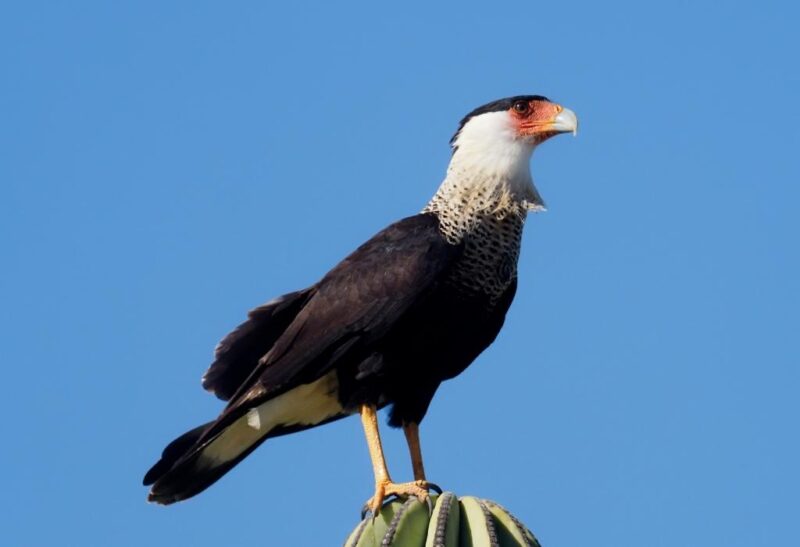Falcons are fast and efficient hunters that have aerodynamic torsos and wings that are biologically designed for soaring and capturing prey at incredible speeds. There are various species found in a variety of habitats in North America.
So, what are the types of falcons in North America? These are the Collared Forest falcon, Aplomado falcon, Crested Caracara, Prairie falcon, Gyrfalcon, Peregrine falcon, Merlin, and American Kestrel—for a total of 8 falcon species.
This article will provide you with everything you have to know about falcons that can be found in North America, their physical attributes, habitats, places of origin, distinctive characteristics, food preferences, and more!
Table of Contents
How Do I Identify a Falcon?
True falcons will have long, pointed wings with relatively short tails compared to other raptors. However, there are certain exceptions, such as Forest falcons, like the Collared Forest falcon, and the Crested Caracara, which have rounded wings and longer tail lengths.
Most falcons usually perch on trees, and when they do, they sit upright, which will make them easier to identify. It’s important to note that you would most likely hear falcons instead of seeing them as they are vocal and like to make whistles, squawks, and strident notes.
Are Hawks and Falcons the Same?
Hawks and falcons are not the same. Falcons belong in the genus Falco while hawks belong in the family Accipitridae and have several genera, including the genus Buteo and Accipiter. Hawks are larger than falcons and also have shorter wingspans.
How Many Types of Falcons Are There in North America?
There are 8 types of falcons present in various habitats in North America. These are the Collared Forest falcon, Aplomado falcon, Crested Caracara, Prairie falcon, Gyrfalcon, Peregrine falcon, Merlin, and American Kestrel.
Get to know more information about these birds below:
Collared Forest Falcon

Collared Forest falcons are neotropical raptors that have excellent maneuverability skills due to their long legs and equally long tails, making them chase prey by foot with great speed, although they are naturally perch-and-swoop hunters.
- Scientific Name: Micrastur semitorquatus
- Appearance: Large-sized bodies with long legs and rounded tails
- Color: These falcons come in three color morphs: pale, dark, and tawny. They generally have creamy white underparts, a dark head and back, a black and white tail, and yellow legs. They’re characterized by two dark bands around their necks, resembling a collar.
- Lifespan: Up to 20 years (wild)
- Habitat: Forested habitats, usually along forest edges, with dense undergrowth or canopies. They occasionally live on cavities found in rocky cliffs or abandoned buildings.
- Length: 46 to 58 centimeters
- Weight: 479 to 940 grams
- Wingspan: 72 to 86 centimeters
- Diet: Small mammals (squirrels, rats, bats), snakes, lizards, birds, frogs
- Place Of Origin: Central and South America
- Characteristics: Sedentary and actively hunting around dusk and dawn.
Aplomado Falcon

Often found in pairs as they prefer to live together and hunt cooperatively, Aplomado falcons are considered endangered, specifically those populations found in Northern US and Mexico. They are fast and strong flyers but prefer to hunt prey on foot.
- Scientific Name: Falco femoralis
- Appearance: Medium-sized falcons with square heads, long legs, pointed wings, and long and narrow tails
- Color: Gray dorsal plumage, a dark band and shades of brown to rufous on the belly, white upper breast, striped black, and white tail, and distinctive bold black and white face markings
- Lifespan: Up to 8 years (wild), Up to 20 years (captivity)
- Habitat: Savannas, desert or arid grasslands, and coastal prairies
- Length: 38 to 43 centimeters
- Weight: 208 to 500 grams
- Wingspan: 89 centimeters
- Diet: Birds (doves and pigeons), large insects, small mammals, lizards, woody plants
- Place Of Origin: South America
- Characteristics: Partial migrants, as some populations make short-distanced migrations while others are sedentary. They’re solitary unless they have a pair or mate.
Crested Caracara
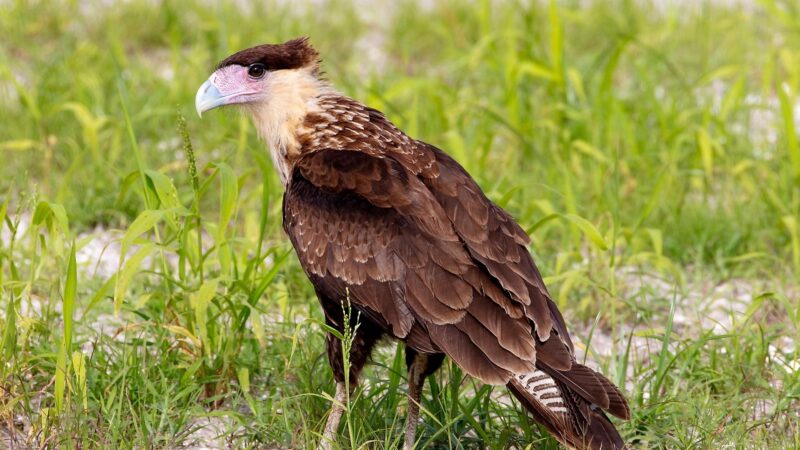
Resembling a long-legged hawk and behaving like a vulture, Crested Caracaras are usually easy to spot, especially in open areas and landscapes. They’re also frequent walkers when looking for prey and are the only falcon species that collect nesting materials and build nests.
- Scientific Name: Caracara cheriway
- Appearance: Medium-sized falcons with bulky bodies, long legs, flat heads, shaggy crests, long straight wings, and a diamond-shaped tail
- Color: Black and white plumage characterized by a black crown that contrasts their red facial skin, white cheeks and neck, and yellow-orange beaks. Outer flight feathers are white, while tails are banded with black and white.
- Lifespan: Up to 25.8 years (wild)
- Habitat: Open grasslands, scrubby areas, rangelands, and deserts
- Length: 49 to 58 centimeters
- Weight: 1.05 to 1.3 kilograms
- Wingspan: 122 to 125 centimeters
- Diet: Carrion, small turtles and turtle eggs, insects, small birds, fish, frogs, snakes, lizards
- Place Of Origin: Southern United States
- Characteristics: Sedentary and solitary unless when gathering at sources with a lot of food.
Prairie Falcon
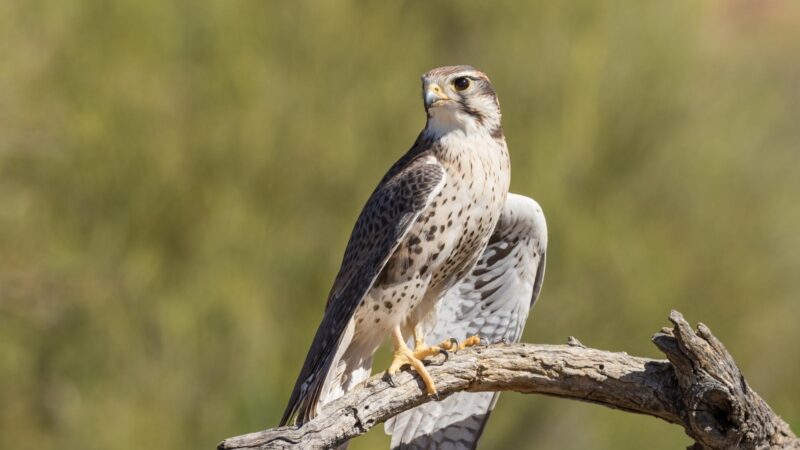
Despite being known to be the most territorial and aggressive out of all the raptors when defending their habitats, Prairie falcons (usually as nestlings) are a popular choice for falcon owners and enthusiasts to own and train.
- Scientific Name: Falco mexicanus
- Appearance: Large bodies with squarish heads, relatively long tails, and pointed wings
- Color: Brown upper parts, pale underparts with brown markings, distinctive white patches between the eyes and the ear, black malar streaks, and a brown mustache-like stripe. Their dark axillaries (“armpits”) stand out during flight.
- Lifespan: 2.4 to 9.1 years (wild)
- Habitat: Open habitats such as deserts, agricultural fields, sagebrushes, prairies, forested areas, grasslands, and alpine meadows that have an 11,000-foot elevation
- Length: 37 to 47 centimeters
- Weight: 420 grams to 1.1 kilograms
- Wingspan: 90 to 113 centimeters
- Diet: Primarily small mammals such as ground squirrels, but they also feed on insects, pikas, and birds such as doves and shorebirds.
- Place Of Origin: North America
- Characteristics: Migratory birds that are solitary unless during the breeding season. They’re playful birds that usually dust-bathe, but they also bathe in water when available.
Gyrfalcon
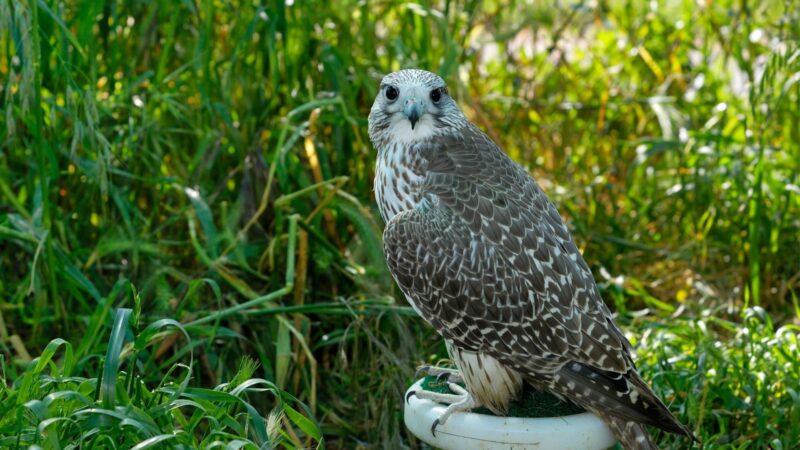
Gyrfalcons are unmistakable ghostly predators that can catch prey at incredible speeds, no matter if they have to chase them through the sky or plummet towards the near ground. They’re considered the largest true falcon in the world and are highly esteemed by falconers.
- Scientific Name: Falco rusticolus
- Appearance: Large-sized and thick bodies with pointed wings, notched beaks, and long tails
- Color: They have dark, white, and gray color morphs. Dark morphs are dark gray or nearly black in plumage. White morphs are pure ghostly white with markings on the wings. Gray morphs are characterized by two tones of gray on their bodies.
- Lifespan: Up to 15 years and 9 months (wild)
- Habitat: Mainly in the alpine and arctic tundra, but other habitats include rocky seacoasts, mountainous terrain, river and lake bluffs, and offshore islands.
- Length: 48 to 64 centimeters
- Weight: 800 grams to 2.1 kilograms
- Wingspan: 123 centimeters
- Diet: Primarily ptarmigans, ground squirrels, and hares, but they also prey on other birds such as seabirds, songbirds, and waterfowl, as well as small mammals such as voles, lemmings, and mice.
- Place Of Origin: High Arctic regions
- Characteristics: Solitary or in pairs and migratory. They’re extremely monogamous as they mate for life. Highly territorial and capable of aggressively striking intruders. Their flight speeds can reach 130 miles per hour.
Peregrine Falcon
Peregrine falcons are historically referred to as duck hawks despite being true falcons. They’re often regarded as the fastest birds in the world, able to reach 238 miles per hour when descending rapidly from the sky.
- Scientific Name: Falco peregrinus
- Appearance: Although they vary in size depending on location, they’re generally medium-sized falcons with large heads, long tails, and long tapered wings.
- Color: Blue-gray upper parts and wings with dark heads and sideburns, barred pale underparts, and white faces with distinctive black stripes on each cheek
- Lifespan: Up to 20 years (wild), Up to 25 years (captivity)
- Habitat: They have historically occupied open landscapes found in river bluffs, marshes, and cliffs but are now also found in urban and industrial areas such as tall buildings.
- Length: 36 to 49 centimeters
- Weight: 530 grams to 1.6 kilograms
- Wingspan: 100 to 110 centimeters
- Diet: Prefer medium-sized birds such as shorebirds, pigeons, grackles, and starlings, but they also feast on large birds such as sandhill cranes and small birds such as hummingbirds. Occasionally, they feed on rodents and fish captured by other raptors.
- Place Of Origin: Western Eurasia and Africa
- Characteristics: Diurnal, highly territorial, migratory, and solitary unless during the breeding season.
Merlin
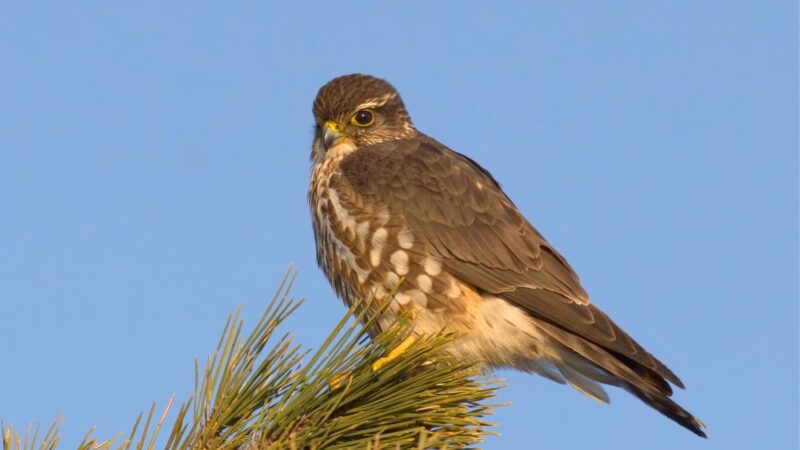
Colloquially referred to as pigeon hawks, merlins are excellent at maneuverability while flying compared to other falcons. They have successfully increased their population by a nearly 2% annual rate between 1966 to 2019, according to the North American Breeding Bird Survey.
- Scientific Name: Falco columbarius
- Appearance: Small-sized and compact but have relatively broad and stocky bodies and chests, pointed wings, and medium-length tails.
- Color: Males have slate blue, dark brown, or purplish upper parts, while females have dark brown upper parts. Both are black-streaked and have barred white-tipped tails, pale underparts, and bluish beaks.
- Lifespan: Up to 11 years (wild), up to 15 years (captivity)
- Habitat: Open country areas such as woodlands, grasslands, sand dunes, deserts, marshlands, seashores, and steppes
- Length: 24 to 33 centimeters
- Weight: 160 to 240 grams
- Wingspan: 53 to 68 centimeters
- Diet: Primarily small birds such as house sparrows, larks, dunlins, least sandpipers, finchers, grouse, and ptarmigans. They also feed on small mammals, insects, lizards, and snakes.
- Place Of Origin: North America and Eurasia
- Characteristics: Solitary except during mating season and when raising their young. Highly territorial during the breeding season and are seasonally monogamous as they find new mates annually. They’re migratory and sometimes fly in loose groups.
American Kestrel
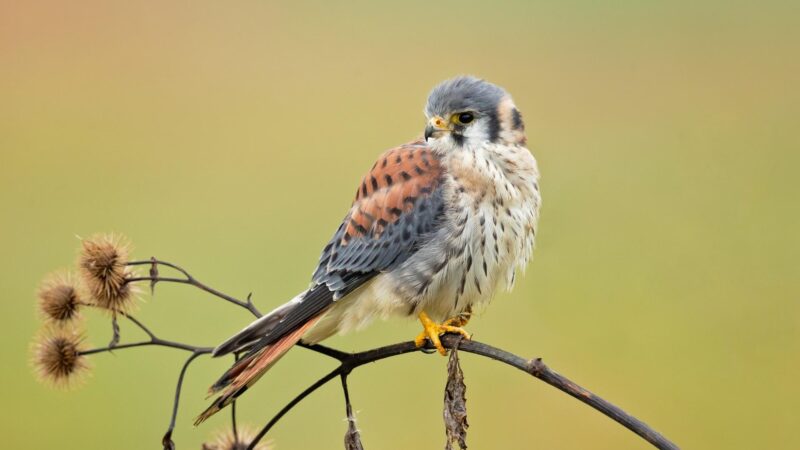
American Kestrels are the smallest falcons in North America and have the widest distribution. They can easily be spotted on exposed perches in agricultural lands and towns. They were called sparrow hawks before they were officially renamed.
- Scientific Name: Falco sparverius
- Appearance: Small and slender bodies, narrow pointed wings, and square-tipped tails
- Color: Pale underparts, brown upper plumage with brown spots, and patterned with black vertical stripes. Males have slate-blue wings and unbarred tails, while females have reddish brown wings and barred tails.
- Lifespan: Up to 11 years (wild), up to 17 years (captivity)
- Habitat: Found in a variety of habitats as they are highly adaptable, such as pastures, roadsides, croplands, urban and suburban communities, open fields, tropical lowlands, and mountains.
- Length: 22 to 31 centimeters
- Weight: 80 to 165 grams
- Wingspan: 51 to 61 centimeters
- Diet: Primarily insects, such as cicadas, grasshoppers, dragonflies, and beetles, but they also feed on small mammals such as shrews, voles, bats, and mice. Occasionally, they eat frogs, small snakes, and lizards.
- Place Of Origin: Central and South America
- Characteristics: Diurnal, migratory, and solitary birds, except during breeding season. They’re also highly territorial, especially concerning their prey and nesting sites.
What Is the Most Common Falcon in the US?
American Kestrels have a wide distribution in the US. The total population in the United States and Southern Canada combined is 236,000 individual wintering American Kestrels, according to the Wyoming Species Account.
What Is the Name of a Small Falcon?
Not only are American Kestrels widely distributed, but they are also considered the smallest falcon species in the world. They can reach up to 31 centimeters in length but have long wingspans.
What Is the Most Common Falcon in North America?
American Kestrels are the most common falcon species in North America, with an estimated population of greater than 1.2 million pairs, according to the Wyoming Species Account.
What Is the Largest Falcon in North America?
Gyrfalcons are the largest falcon species in North America, reaching a length of up to 64 centimeters and a wingspan of 123 centimeters.
There are 8 species of falcons that can be found in a variety of habitats in North America, namely: Collared Forest falcon, Aplomado falcon, Crested Caracara, Prairie falcon, Gyrfalcon, Peregrine falcon, Merlin, and American Kestrel.
The largest falcon in the region, and the world, are Gyrfalcons, while the smallest and most widely distributed are American Kestrels.
List of Sources
Martínez-Ruiz, M. (2021). Habitat Use and Selection by the Collared Forest-Falcon (Micrastur semitorquatus) in the Tropical Rainforest of Los Tuxtlas Biosphere Reserve, Mexico. Journal of Raptor Research.
Perez, C. J., Zwank, P. J. Smith, D. W. (1996). Survival, Movements and Habitat Use of Aplomado Falcons Released in Southern Texas. Journal of Raptor Research.
Peregrine Falcon. Indiana Department of Natural Resources.
Merlin. Missouri Department of Conservation.
American Kestrel. (2019). Connecticut Department of Energy and Environmental Protection.
